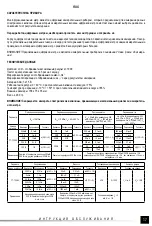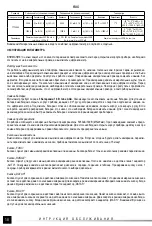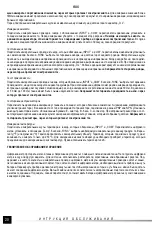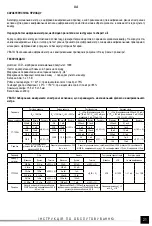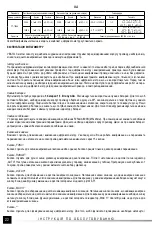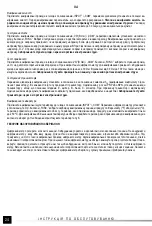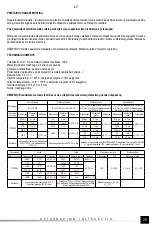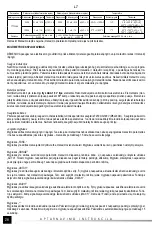
11
O P E R A T I N G M A N U A L
GB
MEASUREMENTS
Depending on the actual position of the range switch in the display three significant digits and the unit of the measured quantity will be
displayed. If it is necessary to replace the battery the multimeter indicates this displaying the battery symbol. If before the measured
value the “-” symbol is displayed, then the measured value has an opposite polarization in relation to the connection of the meter. If
the symbol „O.L” is displayed, the measurement range has been exceeded, and it is necessary to increase the measurement range. In
case of measurements of quantities of unknown values the meter should be switched to „AUTO”, where it will automatically determine
the adequate measurement range.
ATTENTION! The measurement range of the meter must not be lower than the measured value. It might damage the meter
and cause an electric shock.
The correct connection of the leads:
The red lead must be connected to the socket marked as „INPUT” or „10A”
The black lead must be connected to the socket marked as „COM”
In order to ensure the highest possible precision of the measurements the optimum measurement conditions must be observed:
ambient temperature between 18°C and 28°C and relative humidity <75 %
Determination of precision
Precision: ± % of the indi weight of the least significant digit
Measurement of the direct voltage: 1,396 V
Precision: ± (0,8% + 5)
Calculation of the error: 1,396 x 0,8% + 5 x 0,001 = 0, 0,005 = 0,016168
Result of the measurement: 1,396 V ± 0,016 V
Measurements of the voltage
Connect the measurement cables to the sockets marked as „INPUT” and „COM”. Switch the range selector to the position of the
measurement of the direct voltage or alternating voltage. Connect the measurement cables in parallel to the electric circuit and read
the result of the Measurements of the voltage. Do not ever measure a voltage exceeding 300 V. It might damage the meter and cause
an electric shock.
Measurement intensity of the current
Depending on the expected value of the measured intensity of the current connect the measurement cables to the socket marked as
„INPUT” and „COM” or to the socket marked as „10A” and „COM”. Use the knob to select the correct measurement range, and the
button „FUNC.” To select the kind of the measured current. The maximum intensity of the current measured through the „mA” socket
may amount to 200 mA. In case of measurements of the current exceeding 200 mA, connect the lead to the socket marked as „10A”.
The maximum intensity of the current measured through the socket marked as „10A” may amount to 10 A and it is not protected with
a fuse. Therefore the duration of the measurements of currents exceeding 2 A must not exceed 15 seconds, and then it is required
to wait at least 15 minutes before the next measurement. The maximum power-carrying capacity of the „mA” socket amounts to 200
mA.
The maximum current and voltage values of the sockets must not be exceeded.
Connect the measurement cables in series
to the tested electric circuit, select the range and kind of the current and read the result of the measurement. The first stage of the
measurements is to select the maximum measurement range. In order to ensure more precise results of the measurement you may
change the measurement range.
Measurements of resistance
Connect the measurement cables to the sockets marked as „INPUT” and „COM” and switch the range selector to the measurements of
resistance. Place the measurements leads at the terminals of the measured element and read the result of the measurement. In order
to ensure more precise results of the measurements, the measurement range may be changed if required.
It is strictly prohibited to
measure the resistance of live elements.
In case of measurements of values exceeding 1M
Ω
the measurement may take a couple
of seconds before the result is stable, which is a normal reaction during measurements of high resistances.
Before the measurement leads are placed at the measured element the symbol „O.L” is displayed.
Measurement of capacity
Connect the measurement cables to the sockets marked as „INPUT” and „COM”; switch the range selector to the measurement
of capacity. Make sure the capacitor was discharged before the measurement.
Do not ever measure the capacity of a charged
capacitor, since it might damage the meter and cause an electric shock.
In case of measurements of high-capacity condensers
the measurement may last approximately 30 seconds before the result is stable.
Diode test
Connect the measurement cables to the sockets marked as „INPUT” and „COM” and switch the selector to the diode symbol. Use
the „FUNC.” Button to select diode test, after which the diode symbol will be displayed. Place the measurement leads at the diode
terminals in the conduction direction and the reverse direction. If the diode is functioning correctly, then at the diode connected in the

















